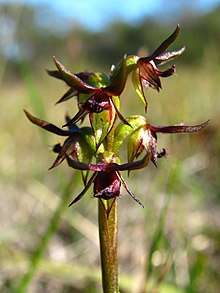Genoplesium archeri
Genoplesium archeri, commonly known as the elfin midge orchid and as Corunastylis archeri in Australia, is a small terrestrial orchid endemic to south-eastern Australia. It has a single thin leaf fused to the flowering stem and up to fifteen small, hairy, yellowish green flowers with purple stripes. It grows in a wide range of habitats in New South Wales, Victoria and Tasmania.
| Elfin midge orchid | |
|---|---|
 | |
| In the Brisbane Water National Park | |
| Scientific classification | |
| Kingdom: | Plantae |
| Clade: | Tracheophytes |
| Clade: | Angiosperms |
| Clade: | Monocots |
| Order: | Asparagales |
| Family: | Orchidaceae |
| Subfamily: | Orchidoideae |
| Tribe: | Diurideae |
| Genus: | Genoplesium |
| Species: | G. archeri |
| Binomial name | |
| Genoplesium archeri | |
| Synonyms[2] | |
Description
Genoplesium archeri is a terrestrial, perennial, deciduous, herb with an underground tuber and a single thin leaf 100–150 mm (4–6 in) long and fused to the flowering stem with the free part 20–25 mm (0.8–1 in) long. Between two and fifteen yellowish green flowers are crowded along a flowering stem 15–30 mm (0.6–1 in) tall and about as tall as the leaf. The flowers are about 7 mm (0.3 in) long and 5 mm (0.2 in) wide and are inverted so that the labellum is above the column rather than below it. The dorsal sepal is egg-shaped, about 4.5 mm (0.2 in) long and 2.5 mm (0.1 in) wide with hairless edges, purple stripes and a pointed tip. The lateral sepals are linear to lance-shaped, about 5 mm (0.2 in) long, 1.5 mm (0.06 in) wide and spread widely apart from each other. The petals are egg-shaped, about 4 mm (0.2 in) long and 1.5 mm (0.06 in) wide with purple stripes and hairless edges. The labellum is purple, broadly egg-shaped, about 3 mm (0.1 in) long, 2 mm (0.08 in) wide, with a curled, sharply pointed tip and coarse hairs up to 1 mm (0.04 in) long on the sides. There is an narrow egg-shaped callus in the centre of the labellum and extending nearly to its tip. Flowering occurs from November to March.[3][4]
Taxonomy and naming
The elfin midge orchid was first formally described in 1858 by Joseph Dalton Hooker who gave it the name Prasophyllum archeri from a specimen collected by William Archer near Cheshunt. The description was published in The botany of the Antarctic voyage of H.M. discovery ships Erebus and Terror. III. Flora Tasmaniae.[5][6] In 1989, David Jones and Mark Clements changed the name to Genoplesium archeri[7] and in 2002 changed the name again to Corunastylis archeri.[1] The specific epithet (archeri) honours the collector of the type specimen.[8]
Distribution and habitat
Genoplesium archeri grows in a wide range of habitats including swamp margins and open forest. It is found in New South Wales mainly between Guyra and the Blue Mountains, is widespread in Victoria and in Tasmania at altitudes up to 200 m (700 ft) above sea level.[3][4][9][10]
References
- "Corunastylis archeri". APNI. Retrieved 24 January 2018.
- "Genoplesium archeri". World Checklist of Selected Plant Families (WCSP). Royal Botanic Gardens, Kew.
- Jones, David L. (2006). A complete guide to native orchids of Australia including the island territories. Frenchs Forest, N.S.W.: New Holland. p. 179. ISBN 1877069124.
- Jeanes, Jeff. "Corunastylis archeri". Royal Botanic Gardens Victoria. Retrieved 4 November 2018.
- "Prasophyllum archeri". APNI. Retrieved 24 January 2018.
- Hooker, Joseph D. (1858). The botany of the Antarctic voyage of H.M. Discovery ships Erebus and Terror. III. Flora Tasmaniae (Volume 2 No. 6). London: Lovell Reeve. p. 14. Retrieved 24 January 2018.
- "Genoplesium archeri". APNI. Retrieved 24 January 2018.
- Mayfield, Enid (2010). Flora of the Otway Plain and Ranges 1: Orchids, Irises, Lilies, Grass-trees, Mat-rushes and Other Petaloid Monocotyledons. Csiro Publishing. p. 99. ISBN 9780643102002. Retrieved 31 December 2014.
- Jones, David L. "Genoplesium archeri". Royal Botanic Garden Sydney. Retrieved 24 January 2018.
- Jones, David L. (1998). "Contributions to Tasmanian orchidology". Australian Orchid Research. 3 (5): 88.
External links

